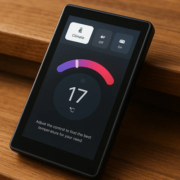Does the Smart Home Control Panel Require Wiring? What You Need to Know About PoE Power
When planning a smart home, one of the most practical — and frequently asked — questions is:
“Does the smart control panel require wiring?”
Closely followed by:
“Does it support Power over Ethernet (PoE)?”
The short answer is: Yes, most professional-grade smart panels require wiring — but PoE support can make things much easier. This article breaks down the differences, benefits, and installation considerations you need to know.
1. Why Wiring Matters for Smart Panels
Smart control panels are not battery-powered like some smart switches or sensors. Because they offer high-resolution touchscreens, real-time data processing, and 24/7 operation, they require constant power and network connectivity.
There are generally two types of wiring used in smart panel installations:
- Electrical Wiring (AC 110V–220V):
Traditionally used to power the panel through a dedicated power source. This requires professional installation and is often done during construction or renovation. - Ethernet Wiring (Cat5e/Cat6 LAN):
Used for data communication, allowing the panel to connect to the local network, smart home hub, or the internet.
2. What Is PoE and Why It’s a Game-Changer
PoE (Power over Ethernet) combines both power and data into a single Ethernet cable. This technology is ideal for smart home control panels because:
- Simplifies installation — no need to pull both a power cable and a network cable
- Safe and low-voltage — reduces electrical risk, especially for low-current systems
- Cleaner look — fewer cables mean a more professional and minimalist wall setup
- Centralized power — panels can be powered from a PoE switch or injector, ideal for rack-mounted smart home systems
Depending on your panel’s power consumption, you’ll need:
- PoE (IEEE 802.3af) — up to 15.4W
- PoE+ (IEEE 802.3at) — up to 30W
- PoE++ (IEEE 802.3bt) — for higher performance devices
3. Does Every Smart Panel Support PoE?
Not all panels are PoE-capable. Many consumer-grade smart displays or tablets don’t support it and require separate AC adapters or USB power.
However, most commercial or professional smart home control panels, especially those used in smart hotels, luxury homes, or offices, now support PoE or PoE+.
4. Portworld Smart Panels with PoE Support
Portworld’s range of smart panels — including the YC-SM10P, YC-SM08M, and YC-SM55P — are designed with PoE support built-in, offering the ideal solution for both residential and commercial integration.
- Built-in PoE (IEEE 802.3af/at)
- RJ45 Ethernet for stable network connectivity
- Simplified installation with just one cable
- Optional DC power supply or AC wiring for flexible deployment
- Professional wall-mount design compatible with 86-type junction boxes
Whether you’re working on a new build, renovation, or smart system upgrade, Portworld panels offer flexibility, ease of installation, and long-term reliability.
5. Installation Tips: When and How to Plan Wiring
- New Construction:
Plan Ethernet runs to panel locations early. Use CAT6 cable for future-proofing. - Renovation Projects:
Consider PoE injector kits or surface-mounted conduits if walls are already finished. - Multi-Panel Setups:
Use a managed PoE switch to power and monitor all panels from a central location.
Yes — most smart home control panels require wiring, and PoE makes that process significantly simpler. Choosing a panel with PoE support not only reduces installation complexity but also ensures cleaner aesthetics, centralized power management, and greater scalability.
If you’re building a modern smart home, PoE-enabled control panels like those from Portworld are the smarter choice.




